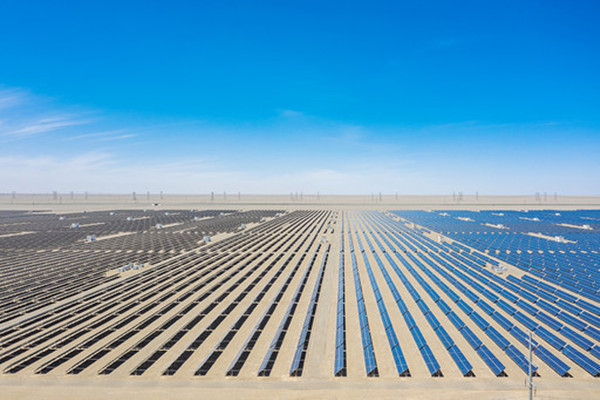


CPC plenum holds domestic, global relevance

A photovoltaic power station in Dunhuang, Gansu Province Photo: TUCHONG
The international community has widely hailed the Third Plenary Session of the 20th CPC Central Committee, which was held from July 15 to 18, as a landmark event of strategic significance, believing that it marks a new era in China’s reform journey. To explore the domestic and global influence of the third plenum of the 20th CPC Central Committee, CSST interviewed Mohammed Saqib, secretary general of the India-China Economic & Cultural Council, and Stephan Ossenkopp, a researcher at the Schiller Institute in Germany.
Holistic, long-term perspectives
At the plenum, a resolution on further deepening reform comprehensively to advance Chinese modernization was adopted. Serving as both a roadmap and timetable, the resolution has been viewed as a document that plays an overarching and guiding role. Saqib noted the positive signals that the landmark meeting sends, saying that the convening of the session has captured global attention and has become a key source for the latest updates on China. In his view, the session provides the world with a window into the reasons, directions, and plans behind China’s reform. The full text of the resolution is clear, and outlines the broad range of sectors covered by further, deeper reform.
Discussing the shift from “deepening reform comprehensively” to “further deepening reform comprehensively,” Saqib explained that the term “further” denotes a more ambitious stage, involving a top-down, systemic approach to all matters concerning broad-based Party building, economic growth, national governance, cultural prosperity, public service delivery, and other matters related to social transformation. As a result, reform will serve as an instrument for resolving long-term structural problems while achieving balance and sustainability.
“I noticed that this session sets the target by 2035, when China aims to basically realize socialist modernization. The reform measures over the next five years were planned. As was emphasized, the reform tasks laid out in this resolution shall be completed by the time the PRC celebrates its 80th anniversary in 2029. These tasks include advancing modernization, promoting high-quality development, and pursuing high-standard opening up, which could have profound effects on China as well as the entire globe,” Saqib said.
Ossenkopp told CSST that this plenum has helped to inform the world about China’s new round of reform. He highlighted that the resolution eyes for the middle of this century, and sets a clear, specific, and easy-to-implement timetable. The holistic approach and long-term perspective, extending to the middle of the century, are unique in the world.
Fruitful results
“Since the new era, China has taken many new measures of reform within China and externally beyond its borders. The reform plans under President Xi Jinping’s leadership have guided China onto a path of reform that is more confident and determined,” Saqib stated.
“China puts particular emphasis on the holistic approach to reform. While dedicating to implementing reform measures, China tries to increase popular participation in the nation-building process and boost the role of national consciousness as the bearer of national pride and cultural confidence. In recent years, China’s reform measures have achieved fruitful results. Urban and rural areas are linked more closely and brought into greater sense of happiness,” Ossenkopp said.
Economic reform remains key
The resolution indicates that economic reform will remain central to China’s future plans. In this regard, Ossenkopp commented that since the Third Plenary Session of the 11th CPC Central Committee in 1978, China’s focus has been on economic structural reform. “I am impressed by China’s measures adopted in economic governance. China tries to improve the business environment and increase the role of private enterprises in the national economic system,” he remarked.
As Saqib observed, economic modernization has been the most significant aspect of Chinese modernization. Since 1978, it has driven enormous internal change, lifting hundreds of millions of Chinese people out of poverty while establishing China as the world’s second largest economy. Nevertheless, it has also led to uneven growth, including income disparities and regional imbalances. Despite these challenges, the CPC has remained resolute in its efforts.
Fostering int’l cooperation, dialogue
“China’s rise is taking place in a sometimes-turbulent international environment. Some Western commentators often focus one-sidedly on the challenges China faces. This often overlooks what China has achieved since reform and opening up. However, it has been proven that China has reformed its governance on its own and is one of the few countries that is confidently pursuing its own development path,” Ossenkopp said.
As Ossenkopp elaborated, China has put forward initiatives to foster cooperation on all issues, promote peace through dialogue, and resolve disputes rationally. This approach positions China as a central player in establishing a fair, equal, and balanced multipolar global order. Through the Belt and Road Initiative, China has created a platform for systematic investment in infrastructure, economic partnerships, and dialogue among civilizations. Additionally, China is constructively engaged in all major multilateral platforms.
“The Chinese government has shown great wisdom, courage, and determination in seeking a reform agenda despite pressure from both domestic and international environments. All these have created miracles across the history of China’s reform,” Saqib concluded.
Editor:Yu Hui
Copyright©2023 CSSN All Rights Reserved